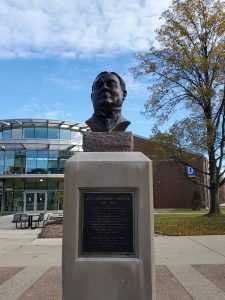Part Three Editing / Grammar Skills
Unit 7 Sentence Essentials
Learning Objectives
- To distinguish between a phrase and a sentence
- To identify the four basic parts of a sentence: subject, verbs, object, subject complement
- To understand the five basic sentence patterns
- To learn how to expand a basic sentence by adding adjectives, adverbs, phrases, and clauses
- To learn and practice three sentence structure types – simple, compound, and complex – with appropriate punctuation through multiple examples and exercises
From this unit on, you will be focusing on editing / grammar skills to enable to you to express your ideas accurately and effectively in paragraphs and essays.
I. Pretest

The following ten parts are about the Early Childhood Laboratory School at Harper College. Identify the structure by choosing one of the choices. After you finish one sentence, you will get instant feedback on your answer before the next sentence. If you make mistakes, you can retry all the questions or see all the answers at the end of the pre-test.
Adapted from https://www.harpercollege.edu/labschool/index.php. Last retrieved on August 1, 2021.
II. Differences Between a Phrase and a Sentence
A phrase is two or more words used together to represent part of an idea but not a complete idea. There is not a “subject + verb” structure in the phrase. The following are examples of some common types of phrases:
- Noun phrases: boys and girls, an excellent school, picture books…
- Verb phrases: play together, read a story, learn shapes and colors…
- Prepositional phrases: in the classroom, on the wall, from home to school…
A sentence may contain different phrases. It has the following features:
- It must have a “subject + verb” structure.
- The first letter of the first word is always capitalized.
- It must end with a period, a question mark, or an exclamation mark.
- It must express a complete idea.
Read the three sentences below. All of them show these features.
- The boys and girls play together in the Early Childhood Laboratory School.
- Are they learning shapes and colors in the classroom?
- What a beautiful painting it is on the wall!
A sentence is usually longer than a phrase but not always. Do not judge by how long it is; instead, look for the “subject + verb” structure.
- Phrase: after a long nap on a beautiful mat in the corner of the nap room (no “subject + verb” structure)
- Sentence: He woke up. (“subject + verb” structure)
For explanations and examples with periods, question marks, exclamation marks, commas, semi colons, colons, apostrophes, and quotations marks, please refer to Appendix C Punctuation. (Open Appendix C here.)
Exercise 1. Identify whether the following are phrases or sentences. Type in the box “phrase” or “sentence”. The first one is an example. When you complete the entire exercise, you can click “Check” for feedback. You may retry or see all the answers.

III. Basic Sentence Parts and Sentence Patterns
Four Basic Parts of a Sentence
1. Subject: It shows who/what does the action. It can also show who/what the sentence is about. It usually comes first in the sentence.
- The writing class is important.
- The students work hard in this class.
2. Verb: It usually comes after the subject and shows the action or explains the ideas in a sentence.
- The teacher meets the students in Room D-144 every week.
- The homework assignments seem interesting.
3. Object: It is usually the receiver of the action and is placed after the verb.
- All the students have finished homework on time.
- They have received good grades.
4. Subject complement: It usually follows a linking verb and shows what the subject is about. It can be a noun or an adjective.
- This is a writing class. (noun)
- The students grow confident in writing. (adjective)
For more detailed explanations and examples of types of verbs, please refer to Unit 9 Verb Basics in Academic Writing. (Open Unit 9 here.)
Five Basic Sentence Patterns
1. Subject + verb
- The semester has started.
- Professors teach in colleges.
2. Subject + linking verb + subject complement (noun or adjective)
- This is a writing class. (noun)
- The weather turns cold as the semester goes on. (adjective)
3. Subject + verb + direct object
- We are taking a writing class.
- I like my classmates.
4. Subject + verb + indirect object + direct object
- The professor gives the students homework assignments.
- The students left the professor a note yesterday.
5. There + a form of “be” verb
- There are twenty students in this class.
- There was a quiz last week.
With these basic patterns, you can expand the sentences by adding descriptive information with adjectives, adverbs, phrases, clauses, etc. The underlined parts are added to make the above sentences more interesting.
- This is an interesting writing class.
- All the students work really hard in this important class in order to improve their writing skills.
- The weekly homework assignments seem very interesting because students write on different topics.
- The students gradually grow more confident in writing as the semester goes on.
- There are twenty young and energetic[1] students from different countries in this writing class.
Exercise 2. Here is more information about the Early Childhood Laboratory School at Harper College. Arrange the words and phrases into sentences. When you complete each sentence, you can click “Check” for feedback. You may retry or see the answer.
Then try to expand the sentences by adding adjectives, adverbs, phrases, or clauses. Capitalize and punctuate where necessary. Underline the added parts. You can do this second part in your notebook. Compare your expanded sentences with your partner’s.
Example:
provides/to many families/a childcare option/The Early Childhood Laboratory School
Sentence: The Early Childhood Laboratory School provides a childcare option to many families.
Expand the sentence: The Early Childhood Laboratory School at Harper College provides an excellent child care option to many busy families in the community.
IV. Sentence Structure #1: Simple Sentences
A simple sentence has only one “subject + verb” group from the beginning of the sentence (with a capitalized letter) to the end (with a period, a question mark, or an exclamation mark).
- Students take classes.
- Learning is important.
- Maria and Sung have three classes.
- Maria and Sung study and work every day.
- They are taking classes and working part time.
- Ana goes to only one class.
- Ana does not have a job.
- Are Maria, Sung, and Anna busy?
- Ana is not busy.
- Maria and Sung have been working too hard!
All the above sentences have only one “subject + verb” group, so they are all simple sentences.
Read #3 and #8 again. You see a compound subject in each.
Compound subject: two or more subjects share the same verb.
3. Maria and Sung have three classes.
8. Are Maria, Sung, and Anna busy?
Read #5 again. You see a compound verb in it.
Compound verb: the same subject performs two or more actions.
5. They are taking classes and working part time.
Read #4 again. You see a compound subject and a compound verb in each. Here, multiple subjects perform the same multiple actions.
4. Maria and Sung study and work every day.

The above sentences are all simple sentences, with one subject-verb group in each.
Each sentence is also called an independent clause because it explains a complete, independent idea.
You can understand a simple sentence as an unmarried adult like the single person in the image on the right. He lives an independent life.
Exercise 3. Read the following paragraph about Harper College. Separate each complete, simple sentence with a capital letter in the beginning and a period in the end. Identify the subject and the verb in each sentence. Capitalize the first letter after a period. The first one is an example. (Commas have already been added.)

Example:
in September 1967, Harper College formally opened in Palatine, Illinois
With corrections: In September 1967, Harper College formally opened in Palatine, Illinois.
Subject: Harper College
Verb: opened
Some Information about Harper College
in September 1967, Harper College formally opened in Palatine, Illinois it uses the name William Rainey Harper to honor the pioneer in the community college movement in the United States Dr. William Rainey Harper was the first president of the University of Chicago Harper College is now one of the nation’s premier[2] and largest community colleges every year, it serves more than 35,000 students in Chicago’s northwest suburbs its academic programs have been preparing students for their future study and their careers students can choose to become full time or part time students Harper offers scholarships and financial aids to help students financially. Students should check the college website or call 947-925-6000 for information a registration specialist will provide step-by-step guidance.
Adapted from https://www.harpercollege.edu/about/index.php. Last accessed on August 1, 2021.
V. Sentence structure #2: Compound Sentences
Too many simple sentences will make your writing sound choppy[3]. Therefore, you can combine the ideas to form compound sentences.
- Students take classes, and Anna is no exception. (compound)
- Learning is important, so Maria and Sung are taking three classes. (compound)
- Maria and Sung study every day; besides, they also work part time. (compound)
- Maria and Sung are very busy; however, they feel accomplished[4]. (compound)
A compound sentence has two subject-verb groups and uses words such as “and, so, besides, however” to connect the two parts.

While a simple sentence is like an independent, unmarried person, a compound sentence is similar to a married couple, each independent but connected by love. That connection (love) is called a conjunction.
There are different types of compound sentences. In this course, you are going to learn the two below:
- with one of the coordinating conjunctions FANBOYS
- with an adverbial conjunction
Coordinating Conjunctions: FANBOYS
| Coordinating Conjunctions: FANBOYS (for, and, nor, but, or, yet, so) | |||
|---|---|---|---|
| for: | to explain a reason | or: | to give a choice |
| and: | to add a point | yet: | to show an opposite point (stronger) |
| nor: | to add a negative point | so: | to explain a result |
| but: | to show an opposite point | ||
Compound sentences with FANBOYS should follow the sentence pattern below:
|
Independent Clause |
Comma + FANBOYS |
Another Independent Clause |
|
|---|---|---|---|
|
Subject + verb
|
, for , and , nor (notes below) , but , or , yet , so |
subject + verb
|
|
- We have taken three writing classes, for writing is a very important skill.
- We have a writing class, and we like it.
- We do not have a test this week, nor are we going to have one next week.
- I try to be on time for my writing class, but it’s hard to get up in the morning.
- Next semester, I may take another writing class, or I may choose a grammar class.
- One of my classmates has failed most tests, yet he does not care.
- Writing is challenging, so I am studying very hard.
Nor: The conjunction “nor” requires a slightly different word order: the helping verb comes before the subject. “Nor” already indicates negative, so do not add another “no” or “not”.
- I do not like hot dogs, nor do I like hamburgers.
- He is not going to the library after class, nor is he going home.
- I did not have a good winter break last year, nor did I have a fun spring break.
For explanations and practice in helping verbs, please refer to Unit 9 Verb Basics in Academic Writing. (Open Unit 9 here.)
Not all the sentences with FANBOYS are compound sentences. They must follow the above format to be called compound sentences.
- We are taking this writing course for three reasons.(simple)
- We are taking this writing course, for writing is important. (compound)
- Last week, we had an editing quiz, a vocabulary quiz, and an oral presentation. (simple)
- Last week, we had two quizzes, and we did well in both. (compound)
Exercise 4. The following paragraph is about differences between a university and a community college. Decide whether each sentence is a simple or a compound sentence. Type “S” in the blank if it is a simple sentence and “C” if it is a compound sentence. Explain to your partner why you think so. The first sentence is an example.

Adverbial Conjunctions
They are also called transitions, as in the earlier units. This type of compound sentences is more formal.
| Adverbial Conjunctions (Transitions) | |||
|---|---|---|---|
| also, besides, furthermore, in addition, moreover… : | to add a point | for example, for instance… : | to give an example |
| as a result, consequently, therefore, thus… : | to show a result | however, nevertheless… : | to show an opposite point |
Compound sentences with adverbial conjunctions should follow the sentence pattern below:
|
Independent Clause |
Semi Colon + Adverbial Conjunction + Comma |
Another Independent Clause |
||
|---|---|---|---|---|
|
Subject + verb
|
; also, ; besides, ; furthermore, ; in addition, ; moreover, ; as a result, ; consequently, ; therefore, ; thus, ; however, ; nevertheless, ; for example, ; for instance, |
subject + verb
|
||
- The teachers give us lots of materials in class; also, they require us to study in the Language Lab once a week.
- I am taking two courses at Harper College; in addition, I have a full-time job.
- They have finished all the ESL courses; as a result, they are registering for English 101.
- They had studied very hard; therefore, they passed the test with an A.
- He liked to go on a vacation; however, he was too busy with her classes.
- Many students want to take day classes; nevertheless, they have a job during the day.
- We have many tests this semester; for example, we have one editing quiz in the writing class and one unit exam in the reading class every week.
It is common to break one compound sentence into two simple sentences, with the same adverbial conjunction in the beginning of the second simple sentence. This happens more often when the sentences are long. Put a period after the first independent clause and capitalize the first letter of the adverbial conjunction. Everything else remains the same. There is always a comma after the conjunction.
|
Independent Clause |
Period + Adverbial Conjunction + Comma |
Another Independent Clause |
||
|---|---|---|---|---|
|
Subject + verb
|
. Also, . Besides, . Furthermore, . In addition, . Moreover, . As a result, . Consequently, . Therefore, . Thus, . However, . Nevertheless, . For example, . For instance, |
subject + verb |
||
- I am taking 2 courses at Harper College. In addition, I have a full time job.
- They had studied very hard. Therefore, they passed the test with an A.
- He liked to go on a vacation. However, he was too busy with her classes.
- We have many tests this semester. For example, we have one editing quiz in the writing class and one unit exam in the reading class every week.
Exercise 5. Use the given adverbial conjunctions to combine the simple sentences into compound sentences. Then use the same conjunctions to write two simple sentences.
Example:
Studying a second language is difficult. It is very useful in finding a job. (however)
Compound sentence: Studying a second language is difficult; however, it is very useful in finding a job.
Two simple sentences: Studying a second language is difficult. However, it is very useful in finding a job.
- Almost all the jobs require good speaking skills. They need good writing skills. (moreover)
- Many people from other countries have good technical skills. They need time to perfect their communication skills. (however)
- They are highly motivated to learn. They work very hard. (furthermore)
- They try different ways to improve. Some of them take classes. (for instance)
- They are able to do well at work. Hard work pays off. (therefore)
VI. Sentence Structure #3: Complex Sentences
A complex sentence has at least two subject-verb groups. They are connected with subordinating conjunctions such as “because, as soon as, if”. There are different types of complex sentences. You are focusing on adverbial clauses in this course.
| Subordinating Conjunctions | |||
|---|---|---|---|
| as soon as, before, since, until, when, while… | to express a time | although, though, even though… | to show a contrast |
| as, because, since… | to give a reason | if, unless… | to state condition |
As you recall, a simple sentence is like an unmarried person living an independent life. A compound sentence resembles[5] a couple living together as two independent adults but connected by love.

A complex sentence is like a parent with a baby. Life is certainly more complex with a baby! The parent is independent, representing the independent clause. The baby is dependent on the parent for food, shelter, love, etc., so the baby resembles the dependent clause.
baby : parent = dependent : independent
A baby cannot live by himself or herself. In the same way, a dependent clause cannot exist by itself. It must be connected with an independent clause.
| Dependent Clause: Subordinating Conjunction + subject + verb + Comma | Independent Clause | |
|---|---|---|
| As soon as
Before After Since Until When While As subject + verb, Because Although Even though Though If Unless … |
|
|
- When I got home, my sister was watching TV.
- Because I wanted to finish my homework, I did not go to bed till 12 am this morning.
- Although English is a difficult language, I am trying my best to learn it.
The same complex sentences can also be written as follows. Notice that there is no comma in the middle of the sentence.
| Independent Clause | Dependent Clause:
Subordinating Conjunction + subject + verb |
|
|---|---|---|
| Subject + verb | as soon as
before after since until when while as subject + verb because although even though though if unless … |
|
- My sister was watching TV when I got home.
- I didn’t go to bed till 12 am this morning because I wanted to finish my homework.
- I am trying my best to learn English although it is a difficult language.
Exercise 6. The following sentences are about my classmates. Join two simple sentences into a complex one with the subordinating conjunctions given. Use commas where necessary.
Example:
At 9 am yesterday, Jose was listening to the radio. He was driving to Harper. (while)
Complex: At 9 am yesterday, Jose was listening to the radio while he was driving to Harper.
- Priti has decided to travel to Aruba during the semester break. She has always been interested in its culture. (because)
- This is Amy’s first year in the U.S. She speaks English fluently. (although)
- Lilly did not wake up early on time yesterday. She missed the first part of the class. (as)
- Yuri started an ESL class. He arrived in this city. (as soon as)
- Max had never used a computer. He liked his first online class. (even though)
- Misako ran into her former classmate. She was looking for her new textbook in the bookstore. (while)
- At the end of last semester, Kang Sun returned to Korea to visit her family . She had saved enough money for a plane ticket. (after)
- The next semester starts two months later. Every student needs to decide what classes to take. (before)
VII. Sentence Variety
Just like a balanced diet that keeps the body healthy, a good piece of writing also uses a variety of sentences including simple, compound, and complex structures. Here are some strategies to help you achieve that.
- Try not to repeat the same conjunctions. It is common to overuse[6] words like “and”, “because”. Try a different expression. For example, you may replace “and” with “in addition” and replace “because” with “since”. Change the sentence structure and punctuation accordingly[7].
- When you finish writing, count how many simple, compound, and complex sentences you have included. Ideally, the number of each should be comparable[8]. For example, if there are ten simple sentences and only two complex ones, you may combine some of the simple ones to form one or two more complex sentences. On the other hand, too many compound and complex sentences may be hard to read, and you can improve your writing by changing some of them to simple sentences.
Read the following two paragraphs. Count the number of different sentence types in each paragraph. Discuss which paragraph is better and why.
#1

Fast Track Programs
Harper College has special programs called “Fast Track”. Some students want to finish their study fast. They can choose this option. There are different fast track certificate programs. Each is five to eight weeks long. The certificates include business management, human resources management, web design and interactive media, and others. Each program has a limited number of students, so they can get more personalized[9] interaction with professors. Classes are usually from 6 pm to 10 pm. Students can still work during the day. Besides the certificate programs, there are also fast track degree programs in AAS Degree (Associate in Applied Science) in Business Administration and AAS Degree in Supply Chain Management. Students do not always need to start from the beginning because they can get credit from their previous college or work experience. The fast track programs are convenient and beneficial for many students. It may not suit everyone. The best way to start is to attend an information meeting.
Adapted from https://www.harpercollege.edu/fasttrack/index.php. Last retrieved on November 4, 2021.
In this above paragraph, there are 12 simple sentences, 1 compound sentence, and 1 complex sentence.
#2
Fast Track Programs
Harper College has special programs called “Fast Track”. If some students want to finish their study fast, they can choose this option. There are different fast track certificate programs, and each is five to eight weeks long. The certificates include business management, human resources management, web design and interactive media, and others. Each program has limited number of students, so they can get more personalized interaction with professors. Since classes are usually from 6 pm to 10 pm, students can still work during the day. Besides the certificate programs, there are also fast track degree programs in Associate in Applied Science (AAS) Degree in Business Administration and AAS Degree in Supply Chain Management. Students do not always need to start from the beginning because they can get credit from their previous college or work experience. The fast track programs are convenient and beneficial for many students; however, it may not suit everyone. The best way to start is to attend an information meeting.
Adapted from https://www.harpercollege.edu/fasttrack/index.php. Last retrieved on November 4, 2021.
In the #2 improved version, there are 4 simple sentences, 3 compound sentence, and 3 complex sentences. Work with your partner to identify each type of sentences. Discuss why #2 is better.
Exercise 7. Choose a paragraph you have written this semester and try the following:
- Count how many simple, compound, and complex sentences are in it.
- In what ways can you edit some of them so that the whole piece has a better balance of different structures?
VIII. Unit Review Practice
Exercise 8. Read the following paragraph about the student clubs at Harper College. Identify the types of structures of the underlined sentences. In the boxes, type “simple” for a simple sentence, “compound” for a compound sentence, and “complex” for a complex sentence. The first one is an example. You will get instant feedback on your answers. When you finish the entire exercise, you can retry or see all the answers.

Exercise 9. Read the following paragraph about different ways people learn. Identify the types of structures of the underlined sentences. In the boxes, type “simple” for a simple sentence, “compound” for a compound sentence, and “complex” for a complex sentence. The first one is an example. You will get instant feedback on your answers. When you finish the entire exercise, you can retry or see all the answers.
Exercise 10. Read the paragraph below about the writer’s learning and working experiences. It has too many simple sentences. Combine the underlined simple sentences into compound or complex sentences with the conjunctions given.
Example:
I came to the United States. I had never touched a computer (before).
Before I came to the United States, I had never touched a computer.
Learning and Hoping
Learning and hoping keep me going. Two years ago, I got a job at a company called TechInnova. Now I use the computer at work every day. I came to the United States. I had never touched a computer (before). It did not take me very long to learn basic computer skills. I had already taken a course in typing (for). I left my country four years ago. I had finished secretarial school (by the time). I was looking for a job here, I took a course in information technology (while). Soon I found the job at TechInnova. I have continued to learn new things since then. For example, now I am learning web design through the Fast Track program at Harper College. My company is paying half the tuition for me. I am grateful for that (and). The program is very intensive. I am very busy (therefore). The new skills have boosted my self-confidence and made me feel more hopeful for my future.
Exercise 11. Choose and highlight the most appropriate conjunction for each blank in the paragraph below about learning to play the piano. Look carefully at the punctuation before you decide. The first one is an example. When you complete the entire exercise, you can click “Check” for feedback. You may retry or see all the answers.

Exercise 12. Read the following paragraph about my uncle and me. There are five more mistakes in the use of commas (not including the example). Find them and correct them. The first one is an example.
My Uncle and I
My uncle has had a very positive influence on me in several ways. He came from Pakistan to the U.S. in the 1990s and has made a life for himself and his extended family. First he (First, he…) sponsored me to come to the U.S. a year ago. He made it possible for me to have a chance for a better life. For instance, I am now living in a much cleaner, and safer environment. Second his accomplishments[10] have reminded me to work hard for my own life and for the life of my family. My uncle had worked as a waiter, a construction worker, and a newspaper delivery man before he enrolled at Harper College with a major in business ten years ago. He is now working as regional manager for a food company. He loves his job. Thanks to my uncle, I started a new life, as soon as I arrived here. I have followed his footsteps and have been working very hard since last year. My dream is to work in a finance field so I have been taking math and English as a Second Language courses to prepare for my major. Meanwhile, I have not abandoned[11] my hobby – swimming. I swim a few times a week in the college swimming pool. My uncle always says, that a good future needs good health. I am thankful to my uncle for the inspirations[12] and opportunities.
Exercise 13. Use the suggested conjunctions to expand the following simple sentences by adding one more clause to make new and meaningful compound or complex sentences. Use proper punctuation in each sentence. Share your sentences with your partner.
Example:
I love my community college. (for, as a result, because)
My sentence: I love my community college, for there are many interesting classes like piano and drawing.
My sentence: I love my community college; as a result, I am enjoying my study there.
My sentence: I love my community college because it is close to my home.
- Many people come to the community college. (since, in addition, because)
- Some young people prefer four-year universities. (so, consequently, although)
- Nothing is perfect in all areas. (however, nor, since)
- It all depends on which option works better for each student. (therefore, and, when)
NSNT Practice

Go to The NSNT Free Writing Approach and Additional Weekly Prompts for Writing in Appendix A. (Open Appendix A here.) Choose two topics that you have not written about. You may start with the NSNT approach. Then revise and edit at least your paragraphs. Include some compound and complex structures. Pay attention to punctuation. You are encouraged to share your writing with your partner and help each other improve.
Vocabulary Review

The words here have appeared in this unit. The best way to learn them is to guess the meaning of each word from the context. Then hover your computer mouse over the number beside each word to check its meaning and part of speech. These words are also listed in the footnote area at the end of each unit.
Here, you can use the flashcards below to review these words.
Summary
- A phrase is two or more words used together to form part of meaning but not complete meaning. It does not have a “subject + verb” structure.
- Every sentence must explain a complete idea and have a subject and a verb.
- The most basic sentence parts are subject, verb, object, and subject complement.
- The most basic sentence patterns are
- Subject + verb
- Subject + verb + object
- Subject + linking verb + subject complement (noun or adjective)
- Subject + verb + indirect object + direct object
- There + a form of “be”
- A simple sentence is an independent clause with one subject-verb group.
- A compound sentence has two independent clauses with two subject-verb groups. They are connected by a coordinating conjunction (FANBOYS) or an adverbial conjunction such as “moreover” or “however”.
- A complex sentence has one dependent clause (a subordinating conjunction + subject + verb) and one independent clause (subject + verb).
- It is important to include a variety of sentence types in writing.
Media Attributions
- frame at entrance of Early Childhood Lab School at Harper College © Lin Cui is licensed under a CC0 (Creative Commons Zero) license
- Building D at Harper College © Lin Cui is licensed under a CC0 (Creative Commons Zero) license
- a single person smiling and holding a skateboard © Photo by Monstera from Pexels
- William Rainey Harper statue on Harper Campus © Lin Cui is licensed under a CC0 (Creative Commons Zero) license
- a couple with a heart in between © Photo by Josh Hild from Pexels
- University Center at Harper College © Lin Cui is licensed under a CC0 (Creative Commons Zero) license
- a parent with a baby © Image by Prawny from Pixabay
- Fast Track information session as appeared on Harper College website © Lin Cui is licensed under a CC0 (Creative Commons Zero) license
- International Students Club at Feed My Starving Children © Kathleen Reynolds is licensed under a CC0 (Creative Commons Zero) license
- black and white keys on a piano © Photo by Amir Doreh on Unsplash
- a pen writing in a notebook © Photo by Aaron Burden on Unsplash
- a page in a dictionary © Pixabay
- energetic: adjective, active, full of energy ↵
- premier: adjective, first in rank, leading ↵
- choppy: adjective, broken, not connected ↵
- accomplished: adjective, successful in doing something ↵
- resemble: verb, is similar to ↵
- overuse: verb, use too many times ↵
- accordingly: adverb, as a result, therefore ↵
- comparable: adjective, similar ↵
- personalized: adjective, customized, according to the needs of each person ↵
- accomplishment: noun, success, achievement ↵
- abandon: verb, give up ↵
- inspiration: noun, good influence, example ↵
In writing context, FANBOYS is an acronym for one of the coordinating conjunctions (for, and, nor, but, or, yet, so).

